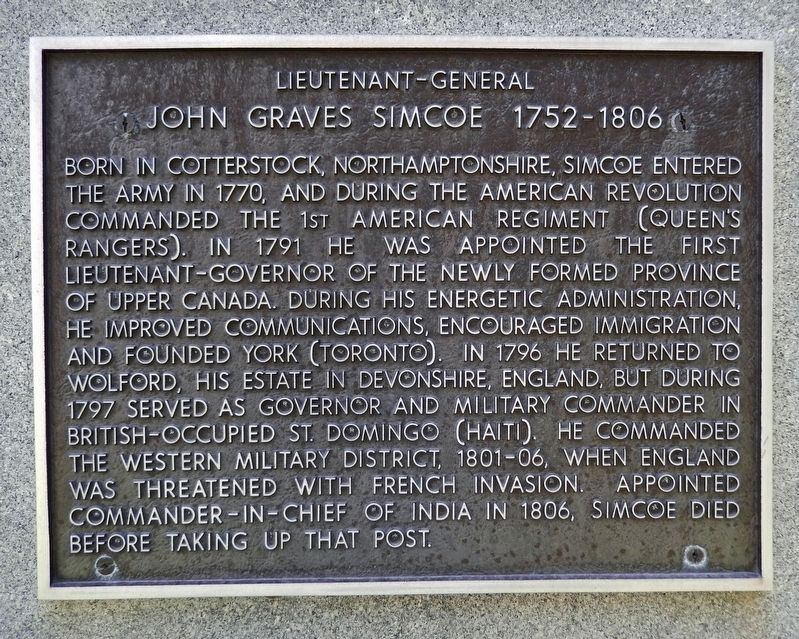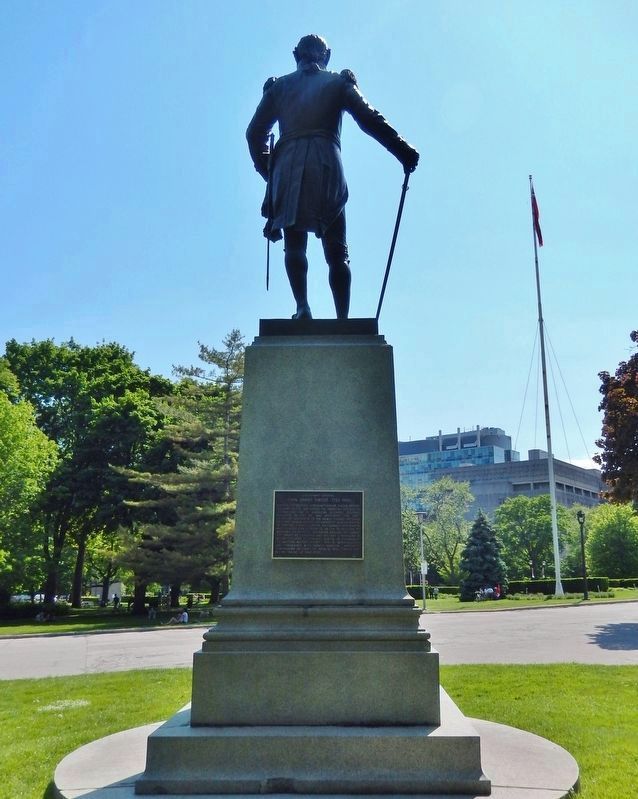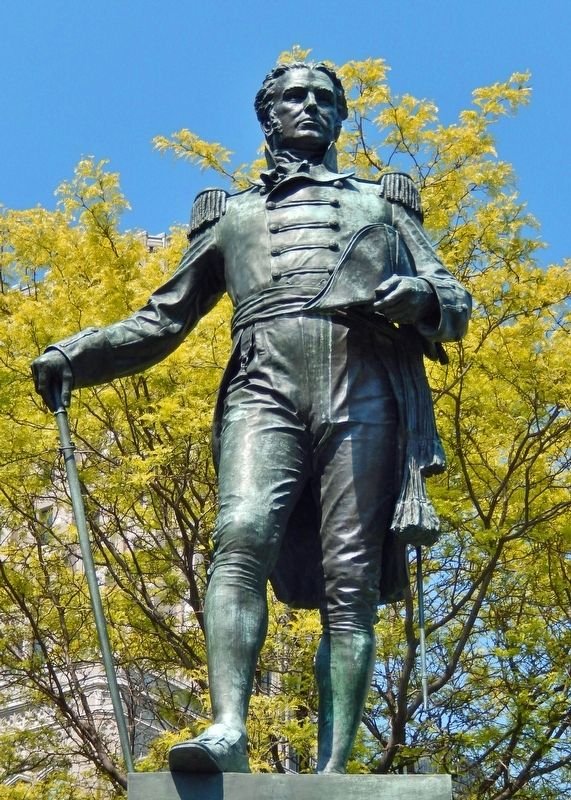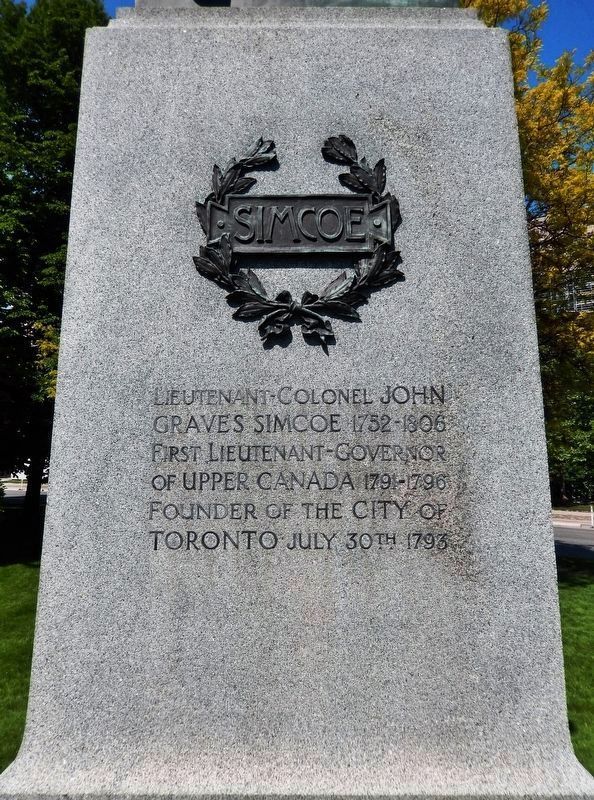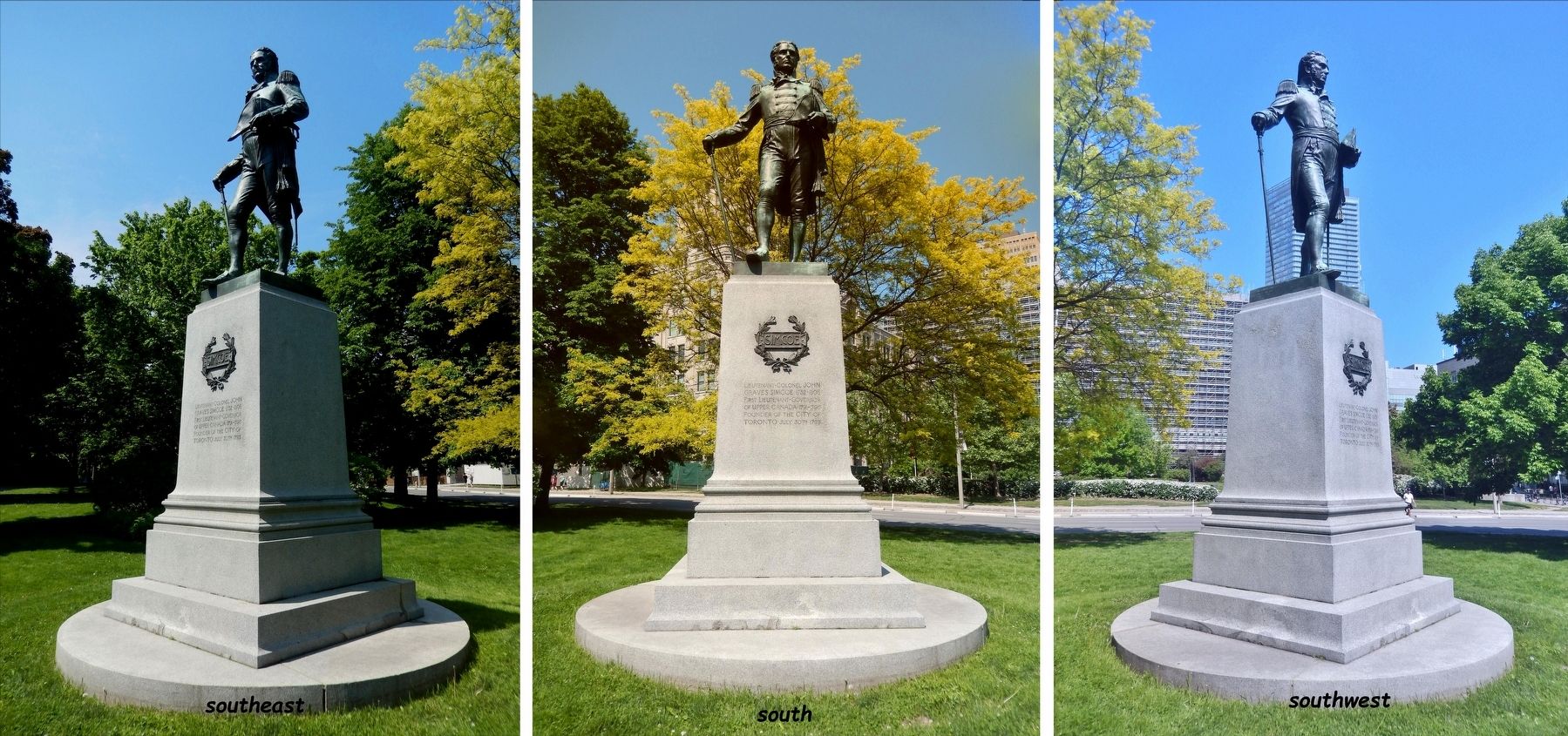Bay-Cloverhill in Toronto, Ontario — Central Canada (North America)
Lieutenant-General John Graves Simcoe
1752-1806
Born in Cotterstock, Northamptonshire, Simcoe entered the army in 1770, and during the American Revolution commanded the 1st American Regiment (Queen’s Rangers). In 1791 he was appointed the first Lieutenant-Governor of the newly formed province of Upper Canada. During his energetic administration, he improved communications, encouraged immigration and founded York (Toronto). In 1796 he returned to Wolford, his estate in Devonshire, England, but during 1797 served as Governor and Military Commander in British-occupied St. Domingo (Haiti). He commanded the Western Military District, 1801-06, when England was threatened with French invasion. Appointed Commander-in-Chief of India in 1806, Simcoe died before taking up that post.
Topics. This historical marker is listed in these topic lists: Government & Politics • War, US Revolutionary. A significant historical year for this entry is 1752.
Location. 43° 39.725′ N, 79° 23.417′ W. Marker is in Toronto, Ontario. It is in Bay-Cloverhill. Marker is on Queen's Park Crescent East just north of Grosvenor Street, on the left when traveling north. Monument is located in Queen's Park, near the southeast corner of the Ontario Legislative Assembly building. Marker is mounted at eye-level on the north side of the monument. Touch for map. Marker is in this post office area: Toronto ON M7A 1A2, Canada. Touch for directions.
Other nearby markers. At least 8 other markers are within walking distance of this marker. Queen Victoria (within shouting distance of this marker); King's College (within shouting distance of this marker); The Printers' Strike of 1872 / La Grève des Typographes de 1872 (within shouting distance of this marker); Ontario Human Rights Code / Code des droits de la personne de l'Ontario (within shouting distance of this marker); Ontario Post One (within shouting distance of this marker); Hon. John Sandfield Macdonald (within shouting distance of this marker); This Maple Tree (within shouting distance of this marker); Sir James Pliny Whitney (within shouting distance of this marker). Touch for a list and map of all markers in Toronto.
Also see . . .
1. John Graves Simcoe.
Simcoe served as an officer with the British army in the American Revolutionary War, but is best known to Canadians as the first lieutenant-governor of the new British colony of Upper Canada, which later became Ontario. Simcoe arrived in Newark (now Niagara-on-the-Lake) in 1792. Given the possibility of renewed hostilities between Britain and the United States, Simcoe determined that Newark, situated on the Upper Canadian–US border, was a strategically poor choice for a provincial capital. He temporarily moved the capital to York on the north shore of Lake Ontario. His preferred site – London in the southwestern part of the colony – did not receive the support of Guy Carleton. So York, current-day Toronto, became the permanent seat of government.(Submitted on October 16, 2022, by Cosmos Mariner of Cape Canaveral, Florida.)
2. John Graves Simcoe.
His long-term goal was the development of Upper Canada (Ontario) as a model community built on aristocratic and conservative principles, designed to demonstrate the superiority of those principles to the republicanism of the United States. His energetic efforts were only partially successful in establishing a local gentry, a thriving Church of England, and an anti-American coalition with select indigenous nations. He is seen by many Canadians as a founding figure in Canadian history, especially by those in Southern Ontario. He is commemorated in Toronto with Simcoe Day.(Submitted on October 16, 2022, by Cosmos Mariner of Cape Canaveral, Florida.)
3. The Anti-Slavery Act of 1793.
Perhaps Simcoe's most important achievement as lieutenant-governor was the limitation of slavery in the province. Initially, Simcoe proposed the outright abolition of slavery. However, the Legislative Assembly opposed this proposal because many Loyalists brought enslaved people with them to Upper Canada after the American Revolution. As a compromise, Simcoe passed legislation that allowed for gradual abolition: slaves already in the province would remain enslaved until death, no new slaves could be brought into Upper Canada, and children born to female slaves would be freed at age 25. This act was the first to limit slavery in the British Empire and remained in force until 1833 when the Emancipation Act abolished slavery in all British holdings, including Ontario.(Submitted on October 16, 2022, by Cosmos Mariner of Cape Canaveral, Florida.)
4. John Graves Simcoe Monument.
The work is a realistic depiction of Simcoe in uniform in a standing pose, his hat in his left hand and a walking stick in his right. The design had been selected from among nine proposals submitted by sculptors from France, Scotland, the United States, and Canada. In attempting to depict Simcoe accurately, Allward was initially impeded by a lack of information about his appearance and uniform, but a reproduction of a memorial to Simcoe in the Cathedral Church of Saint Peter in Exeter, England, gave him the details he needed.(Submitted on October 17, 2022, by Cosmos Mariner of Cape Canaveral, Florida.)
Credits. This page was last revised on October 17, 2022. It was originally submitted on October 15, 2022, by Cosmos Mariner of Cape Canaveral, Florida. This page has been viewed 113 times since then and 20 times this year. Photos: 1. submitted on October 15, 2022, by Cosmos Mariner of Cape Canaveral, Florida. 2, 3, 4, 5. submitted on October 16, 2022, by Cosmos Mariner of Cape Canaveral, Florida.
